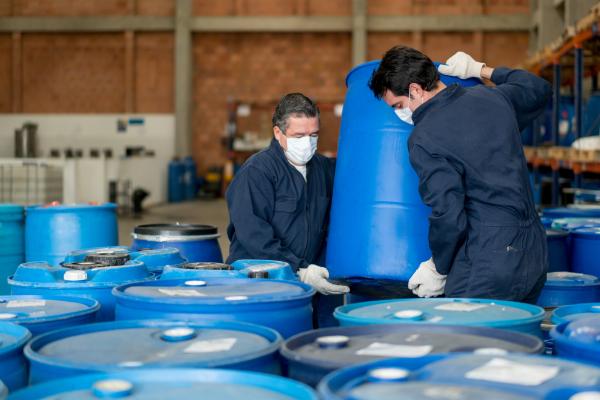Overview
The Regulation on the registration, evaluation, authorisation and restriction of chemicals (REACH) is the main EU law to protect human health and the environment from the risks that can be posed by chemicals. This is done by better and earlier identification of the intrinsic properties of chemical substances and by taking measures, such as phasing out or restricting substances of very high concern. REACH also aims to enhance innovation and the competitiveness of the EU chemicals industry.
REACH places responsibility on industry to manage the risks from chemicals and to provide safety information on the substances. To that end, manufacturers and importers are required to gather information on the properties of their chemical substances and to register that information in a central database in the European Chemicals Agency (ECHA). The Agency is the central point in the REACH system: it manages the databases necessary to operate the system, coordinates the in-depth evaluation of the information provided on chemicals and runs a public database where consumers and professionals can find hazard information.
Objectives
The REACH Regulation aims to:
- ensure a high level of protection of human health and the environment against harmful substances
- assess the safety of chemical substances in use in the EU
- promote innovation and competitiveness
- promote alternative (non-animal) methods for the assessment of the hazards of substances
Law
The REACH Regulation (EC 1907/2006) entered into force in 2007 and has since evolved to reflect the advancement of knowledge regarding various chemicals and their properties.
The Commission is currently revising the REACH Regulation, in line with the Commission’s Better Regulation provisions.
It will include a thorough assessment of possible impacts of potential changes to REACH on
- the protection of human health and the environment
- the use of animal testing
- the functioning of the internal market
- and the competitiveness and innovation of European industry and businesses
The impact assessment and the revision proposal will be informed by existing reviews and studies, as well as several new studies that will assess policy options and impacts. Comprehensive consultations with stakeholders as part of the various studies, to ensure that all views and relevant information is taken into account. Those consultations include
- an open public consultation
- targeted stakeholder consultations of selected groups of stakeholders, as part of individual studies
- expert and policy workshops
- consultation of the expert group Competent Authorities for REACH and CLP (CARACAL) at regular meetings, including in sub-group meetings, where stakeholder representatives are also present. Relevant documents can be found on CIRCABC via the expert group website.
Implementation
Reporting
National competent authorities from EU Member States and EEA countries (Iceland, Liechtenstein and Norway) are required to submit to the Commission every five years a report on the operation of REACH and the compliance with CLP.
See the reports for 2020 and 2015.
Registration
REACH stipulates that chemical substances that exceed 1 tonne per year per company must be registered with ECHA. In this process, companies must identify the risks linked to the substances they handle and indicate how they manage them. This obligation applies to both substances and mixtures.
Key information for companies, especially SMEs
ECHA's registration webpages for more information on REACH registration
Evaluation
ECHA and the Member States then evaluate the information submitted by companies to ascertain whether a given substance poses risks to human health or the environment. Find out more about the evaluation process.
Authorisation
The authorisation process aims to ensure that substances of very high concern (SVHCs) are progressively replaced by less dangerous substances or technologies where technically and economically feasible alternatives are available. Find out more about the authorisation process.
Restrictions
REACH includes a restriction process for certain substances of very high concern if they pose an unacceptable risk to health or the environment. Such substances may be limited or even banned, if necessary. Find out more about the restriction process.
Protecting consumers
Under REACH, consumers have the right to know whether the products they buy contain harmful chemicals. These substances are found in everyday products, and they have been linked to serious and often irreversible effects on health or the environment.
To assist consumers, REACH introduced the "consumer right to know" in Article 33. The LIFE askREACH project helps consumers and companies apply this right.
Upon receiving a consumer inquiry about the presence of a substance of very high concern in an article, companies are obliged to reply within 45 days.
Nanomaterials
Nanomaterials are chemical substances or materials comprising very small particles of different shapes and sizes no larger than 100 nm. Many occur in nature, but most have been engineered to exhibit novel characteristics such as increased strength, chemical reactivity or conductivity compared to their non-nano counterparts.
The REACH Regulation initially made no specific provision for nanomaterials. In 2018 the Commission adopted Commission Regulation (EU) 2018/1881 to modify REACH technical Annexes I, III and VI-XII, introducing nano-specific clarifications and provisions. In 2020 the Commission also updated Annex II with Commission Regulation (EU) 2020/878, introducing new provisions on Safety Data Sheets to complement the new registration requirements for nanomaterials.
In 2011 the Commission adopted the Recommendation on the definition of a nanomaterial. This definition has informed many EU directives and regulations, and has been supported by implementation guidance. The Recommendation was reviewed and revised in 2022 retaining its principal features. Supplemental information about the revised Recommendation has been provided by the Industrial Minerals Association (IMA) and the Germany Federal Institute for Risk Assessment (BfR).
Related links
Main law: REACH Regulation
Related topics: Chemicals,
Related strategies: Chemicals Strategy, Zero pollution action plan, Circular economy action plan, Industrial strategy
Related Commission priorities: European Green Deal






